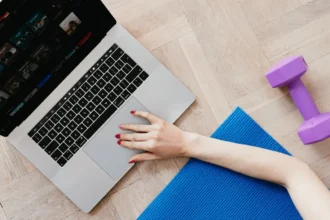
Let’s be honest: not everyone falls in love with exercise. If you’re reading this, chances are you’ve felt the dread of putting on workout clothes, the mental gymnastics of finding excuses to skip the gym, or the frustration of starting and stopping fitness routines more times than you can count. You’re not alone, and more importantly, you’re not broken.
The truth is, you don’t need to love working out to reap its incredible benefits. Millions of people around the world maintain consistent exercise habits despite not particularly enjoying the process. The key isn’t finding your passion for burpees or falling head over heels for the treadmill. Instead, it’s about developing strategies that make exercise feel less like torture and more like a manageable part of your day.
Whether you’re a complete beginner or someone who’s tried and failed multiple times, these seven proven strategies will help you build a sustainable workout routine that sticks, even when motivation feels nowhere to be found.
1. Start Ridiculously Small
The biggest mistake people make when they hate exercise is trying to do too much too soon. If the thought of a 45-minute workout makes you want to hide under the covers, then don’t start there. Instead, embrace what habit formation expert James Clear calls the “2-minute rule.”
Start with exercises so small they feel almost silly not to do. This might mean doing five push-ups against your kitchen counter, taking a three-minute walk around your block, or dancing to just one song while making dinner. The goal isn’t to get an amazing workout; it’s to prove to yourself that you can show up.
These micro-workouts serve a crucial psychological purpose. They help you build the identity of someone who exercises regularly without the overwhelming commitment that typically leads to burnout. When you consistently complete these tiny wins, your brain begins to associate exercise with success rather than failure.
Research from Stanford University shows that small, consistent actions are far more effective for long-term behavior change than sporadic intense efforts. By starting ridiculously small, you’re not just making exercise easier; you’re rewiring your brain to see movement as achievable and normal.
Also read: How to Start Working Out: Complete Beginner’s Guide to Fitness (2025)
2. Find Your “Why” That Goes Beyond Appearance
While wanting to look better is a completely valid motivation, it’s often not enough to sustain you through the tough days when you really don’t want to work out. The most successful exercisers connect their fitness routine to deeper, more immediate benefits that go far beyond physical appearance.
Consider the mental health benefits of regular exercise. According to the Mayo Clinic, physical activity can be as effective as antidepressant medication for treating mild to moderate depression. Exercise releases endorphins, reduces stress hormones like cortisol, and can significantly improve your mood and anxiety levels.
Think about functional fitness goals that impact your daily life. Maybe you want to keep up with your children at the playground, carry groceries upstairs without getting winded, or have the energy to enjoy evening activities after work. These practical motivations often prove more powerful than aesthetic goals because you experience their benefits immediately.
Sleep quality is another compelling reason to exercise regularly. The National Sleep Foundation reports that people who engage in regular physical activity fall asleep faster and enjoy deeper, more restorative sleep. If you struggle with insomnia or poor sleep quality, this benefit alone might be worth the effort.
3. Gamify Your Fitness Journey
If traditional workouts feel like punishment, try turning exercise into a game. Gamification taps into our natural desire for achievement, progress, and friendly competition, making the process more engaging and enjoyable.
Fitness apps like Strava, MyFitnessPal, or Apple Fitness create built-in reward systems with badges, streaks, and achievement levels. These virtual rewards trigger the same dopamine response as real accomplishments, making you more likely to continue your exercise habit.
Create your own personal reward system outside of apps. For every week you complete your planned workouts, treat yourself to something you enjoy: a new book, a favorite coffee, or an episode of your guilty pleasure TV show. The key is to make the reward proportional to the effort and something you genuinely look forward to.
Consider involving friends or family members in friendly fitness challenges. This doesn’t mean you need to compete on who can run the fastest or lift the heaviest weights. Instead, focus on consistency-based challenges like who can complete the most workout days in a month or who can try the most new forms of physical activity.
Track non-scale victories obsessively. Did you climb a flight of stairs without getting breathless? Sleep better after a workout? Feel more energetic throughout the day? These wins are just as important as any physical changes and often provide more immediate motivation to continue.
4. Redefine What “Working Out” Means
One of the biggest barriers to exercise motivation is the narrow definition many people have of what counts as a “real” workout. If your mental image of exercise only includes gyms, sweaty people in athletic wear, and complicated equipment, you’re making things unnecessarily difficult for yourself.
Physical activity comes in countless forms, and the best exercise is simply the one you’ll actually do consistently. Dancing to your favorite music in your living room absolutely counts as cardio. Gardening, cleaning your house vigorously, playing with your dog, or taking the stairs instead of the elevator all contribute to your overall fitness.
Hiking or nature walks can provide excellent cardiovascular exercise while offering the mental health benefits of spending time outdoors. According to research published in Environmental Science & Technology, exercising in natural environments can reduce feelings of anger, fatigue, and sadness more effectively than indoor exercise.
Household activities like vacuuming, washing windows, or rearranging furniture can burn significant calories while accomplishing practical goals. The American Council on Exercise provides data showing that 30 minutes of vigorous house cleaning can burn 90-135 calories for a 125-pound person.
The key is shifting your mindset from “I have to work out” to “I get to move my body.” This simple reframe can transform exercise from something you dread into something that feels more natural and less punitive.
5. Build Your Environment for Success
Environmental design plays a crucial role in habit formation. When you hate working out, removing as many barriers as possible between you and physical activity becomes essential for consistency.
Set up visual cues that remind you of your commitment to movement. Lay out your workout clothes the night before, keep your walking shoes by the front door, or set your yoga mat in a visible location. These environmental prompts serve as gentle nudges toward action when your motivation is low.
If you’re exercising at home, create a dedicated space that’s always ready for movement. This doesn’t require a full home gym; even clearing a small area and keeping a few pieces of equipment like resistance bands or dumbbells easily accessible can make a significant difference.
Remove common obstacles that give you easy excuses to skip workouts. If getting to the gym feels like too much effort, focus on home workouts. If changing clothes feels like a barrier, choose exercises you can do in regular clothing. If time is always an issue, identify 10-minute workout options you can squeeze into busy days.
Finding an accountability partner can provide external motivation when internal motivation fails. This might be a workout buddy, a family member who checks in on your progress, or even an online community of people with similar fitness goals. The key is having someone who expects you to show up, making it harder to skip workouts on difficult days.
6. Focus on How Exercise Makes You Feel
When you dislike the process of working out, it becomes crucial to pay attention to the positive feelings that come after exercise. These post-workout benefits often provide more sustainable motivation than focusing on long-term physical changes.
Start tracking how you feel immediately after each workout and throughout the day. Many people report increased energy levels, improved mood, better mental clarity, and reduced stress after even brief exercise sessions. These immediate benefits can become powerful motivators when you’re struggling to get started.
The endorphin release that follows exercise, often called the “runner’s high,” isn’t limited to running. Any form of physical activity that elevates your heart rate can trigger this natural mood boost. Pay attention to this feeling and remind yourself of it when you’re considering skipping a workout.
Exercise also provides an excellent outlet for stress and negative emotions. Rather than viewing workouts as something you have to do, try reframing them as a tool for managing difficult feelings. When you’ve had a frustrating day, physical movement can help you process and release that tension in a healthy way.
Many exercisers also report improved sleep quality on days when they’re physically active. If you struggle with falling asleep or staying asleep, this benefit alone might provide enough motivation to maintain a consistent exercise routine.
7. Give Yourself Permission to Hate It (While Doing It Anyway)
Perhaps the most liberating strategy is accepting that you don’t have to love every workout. This permission removes the additional pressure of trying to force positive feelings about something you naturally dislike.
The difference between successful and unsuccessful exercisers isn’t about loving every moment of physical activity. Instead, it’s about developing discipline that doesn’t depend on motivation or enjoyment. Think of exercise like brushing your teeth: you probably don’t love doing it, but you do it anyway because you understand its importance.
Focus on showing up rather than perfect performance. A mediocre workout that you actually complete is infinitely better than the perfect workout that exists only in your imagination. Some days, just putting on your workout clothes and doing five minutes of movement is a victory worth celebrating.
Building self-trust through consistency matters more than the intensity or duration of any single workout. Each time you follow through on your commitment to exercise, even when you don’t feel like it, you’re proving to yourself that you’re someone who keeps their word. This builds confidence that extends far beyond fitness.
Remember that motivation is unreliable by nature. It comes and goes based on your mood, energy levels, stress, and countless other factors. Discipline, on the other hand, is a skill you can develop. The more you practice doing things you don’t want to do, the stronger this muscle becomes.
Transform Your Relationship with Exercise Starting Today
Learning how to stay motivated to workout when you hate exercise isn’t about forcing yourself to love something you dislike. Instead, it’s about developing strategies that make consistency possible regardless of your feelings toward physical activity.
Start with just one of these seven strategies rather than trying to implement everything at once. Pick the approach that resonates most with you or feels most manageable given your current situation. Maybe that’s starting with ridiculously small workouts, or perhaps it’s redefining what exercise means in your life.
Remember that progress isn’t always linear, and setbacks are part of the process. The goal isn’t perfection; it’s developing a sustainable relationship with movement that serves your health and wellbeing for years to come.
Your fitness journey doesn’t have to look like anyone else’s, and you don’t need to become an exercise enthusiast to reap the incredible benefits of regular physical activity. You just need to start, stay consistent, and trust that small actions compound into significant results over time.
The most important workout is your next one. Whether that happens today, tomorrow, or next week, you now have the tools to make it happen, even when motivation feels impossible to find.






One Comment